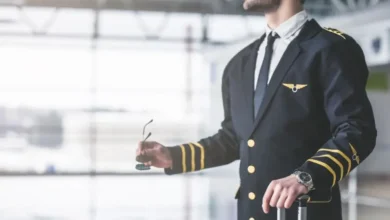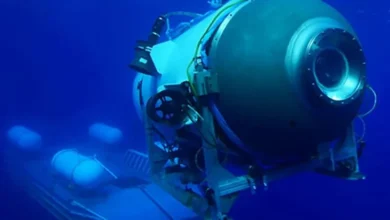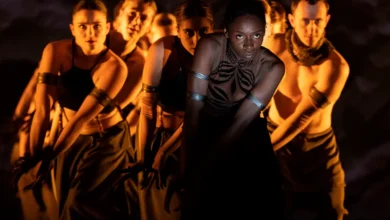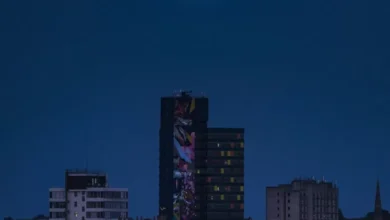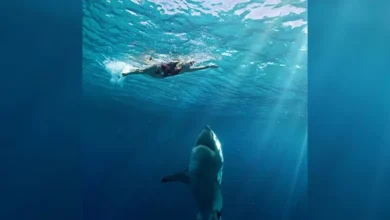How a fictitious ‘sea’ became a top Maldivian tourist attraction
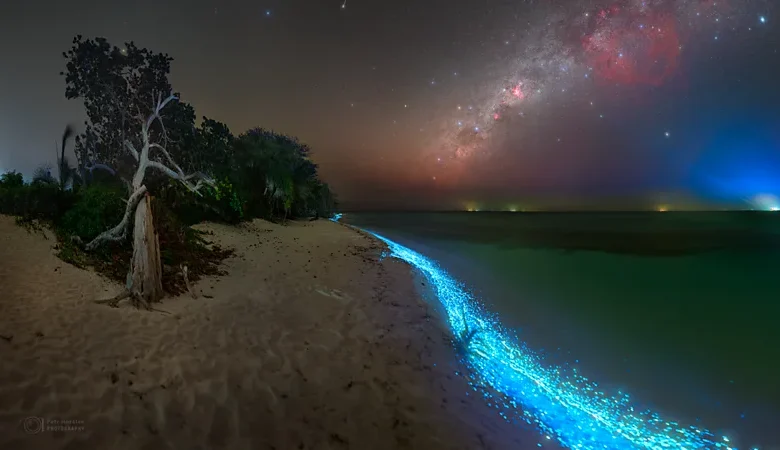
The Maldives’ famous Sea of Stars is part fact, part fiction – but that just adds to the mystery of one of the country’s top tourist attractions.
A glittering expanse of the Indian Ocean glowed blue in the dark as if the stars were submerged underwater after falling from the sky. Along the shoreline, more tiny star-like dots were swept up by waves and tumbled onto the beach, lighting up the wet sand like a reflection of the night sky. They disappeared into the shadows in mere moments. I bounded across the beach and turned round to see my footprints rekindling the lights, leaving a glowing trail behind me. Dipping my toe into the twinkling blue water, the brightness intensified, like a swirling galaxy.
This incredible sight, commonly known as the “Sea of Stars“, is one of the highest-rated attractions in the Maldives. Stunning images of it proliferate online, inspiring adventurous travellers to seek it out. But few people can agree on exactly where you can find the Maldives’ Sea of Stars.
That’s because the Sea of Stars does not actually exist.
To clarify, the Maldives’ mysterious Sea of Stars does not exist as a geographical location. The simple reason for this is that these magical-looking lights are bioluminescent plankton that bob around the ocean.
“When people say they want to see the Sea of Stars in the Maldives, they are actually asking to see a chemical reaction – it’s bioluminescent plankton,” said marine biologist and wildlife presenter Lauren Arthur, who worked in the Maldives for eight years and recently returned to film sea life.
She explained that bioluminescence is a chemical reaction whereby light is produced, while plankton is a collective term for microscopic organisms that can’t control their movements – they just float around in currents. Not all plankton is capable of emitting light (only specific species can), but even then, they don’t emit light all the time, only when they are disturbed, she added. “There’s no one specific place to find bioluminescent plankton. It can be found anywhere in the Maldives, or even anywhere around the world where you get plankton, even the United Kingdom.
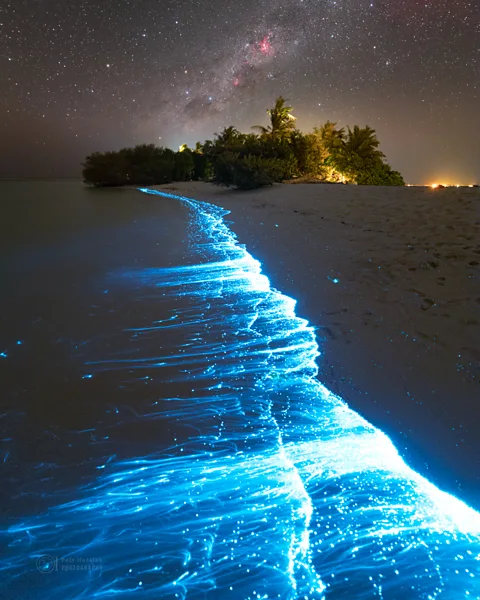 Petr Horalek
Petr HoralekThis means that while the Maldives’ famous Sea of Stars does not exist, you could still see something resembling a sea of stars – although witnessing it will largely come down to luck.
Best ways to see the Sea of Stars
- Visit during the Southwest Monsoon from April till October
- Book a night snorkelling trip with a local operator
- Choose an island with minimal light pollution on the beach
Arthur confirmed my good fortune in previously encountering lots of bioluminescent plankton on several islands around the Maldives, including Olhahali, Kurumba and Hulhumale in North Male’ Atoll. However, I lived in that atoll for five years and frequently return for lengthy visits, unlike most travellers who come to the Maldives for an average just of eight days, which makes seeing this elusive phenomenon harder.
I asked Arthur if a traveller visiting the Maldives on a time crunch can do anything to increase their chances of seeing a sea of stars in the Maldives. She recommended visiting during the Southwest Monsoon (which begins in April and runs until October) when the currents drive plankton from the south-west towards the north-east of the country and the largest amounts of plankton are found.
Arthur also believes you have a higher chance of seeing it underwater than on land.
“You may see it if you’re lucky while you’re sitting on the beach with a nice glass of Champagne, but luck is the key word,” said Arthur. “The best way to see it is to get into the water when it’s thick with plankton and go night snorkelling. It’s one of the most exciting things you can do.”
The best way to see it is to get into the water when it’s thick with plankton and go night snorkelling. It’s one of the most exciting things you can do.
Arthur has also observed bioluminescent plankton many times during the new Moon, when there is very little ambient light, and she recommends travellers take the following steps:
“First, gather your group together in the water then turn off your waterproof torches. The minute you turn them off, it’s very eerie, but just start moving your arms and legs like crazy.” This will create movement in the water column. “You’re disturbing the plankton that will emit light – whether that’s being disturbed by a predator or even a human swimming. As soon as you disturb them, you’re floating amongst the stars.”
A few diving and water-sports centres, such as Maafushi Dive & Watersports, can provide night snorkelling trips, on request, to help you search for bioluminescent plankton.
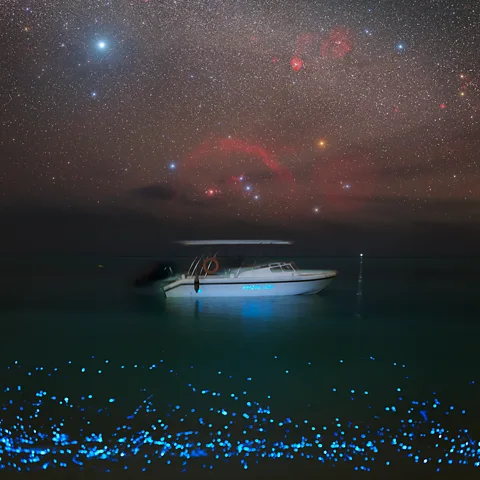 Petr Horalek
Petr HoralekWhile all the marine biologists I spoke to agreed with Arthur, none could offer a biological explanation for why two Maldivian islands with similar sounding names have become famous as the place to see the “Sea of Stars”. “It’s impossible for plankton to be attracted to any single island,” said Arthur.
Yet if you’re one of the 320,000 people a month worldwide searching on Google for “Sea of Stars”, you’ve probably found countless sources urging you to go to Vaadhoo or Vadoo. Vaadhoo is an inhabited island in Raa Atoll with a population of 626, while Adaaran Prestige Vadoo is a private resort island, some 120 miles away in South Male’ Atoll.
The references to these two islands stem back to 2013 when images of a beach covered in beautiful bioluminescent plankton went viral. Vaadhoo or Vadoo was cited as the location, and they continue to circulate to this day. It turns out the reference to Vadoo was probably a misspelling – the resort told me they hadn’t ever seen much bioluminescent plankton, although a small amount was photographed there in the past. I traced the original viral photo to a distinctive coconut tree-fringed beach on Vaadhoo.
All the internet buzz around Vaadhoo has helped generate a regional tourism industry, and four months ago, Ismael “Issey” Naseer, opened Vaadhoo’s first guesthouse, Vaadhoo View Inn. Naseer said although bioluminescent plankton can pop up anywhere in the Maldives, the viral photos of Vaadhoo have drawn many travellers to the area to seek it out. Previously they could only stay on nearby private resort islands and go over by boat, but Naseer decided to develop grassroots tourism on Vaadhoo to benefit the community directly.
“I thought it would be a great opportunity to open up Vaadhoo to the whole world,” said Naseer. “Although we have amazing natural resources like bioluminescent plankton, diving holes and mantas, no one would have the chance to stay here unless we opened the doors to them. We cannot ever guarantee it but I would say 90% of the year it’s possible at least to see at least a little amount of bioluminescent plankton here.”
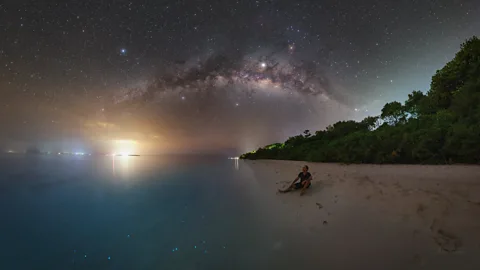 Petr Horalek
Petr HoralekAnd while Vaadhoo certainly isn’t the only island where travellers might be lucky enough to see bioluminescent plankton, the money generated from tourists seeking it out goes directly into local independently owned services such as grocery shops and cafes.
Tips for taking photos of bioluminescent plankton
- Use a tripod
- Set your camera to a long exposure:
– ISO 3200
– f/2.8
– 18mm
– 1.3 sec
This type of tourism has only been permitted in the Maldives since 2009 when guesthouses in island communities were legalised. Previously, travellers could only stay in private resort islands run by hotel brands and were completely segregated from locals.
Like Vaadhoo, many of the Maldives’ 188 inhabited islands are small and have minimal light pollution on the beaches. That’s because Maldivians don’t normally build right on the shore, unlike most resort islands that cater to the foreign appetite for beach villas and over-water restaurants that cast artificial light over the coastline. The darkness on the beaches of the island villages can make it easier to spot bioluminescent plankton if it’s there. And less populated inhabited islands around the Maldives, such as Fulidhoo in Vaavu Atoll, or Dhangethi and Dhigurah in South Ari Atoll, will have the darkest beaches; Dhigurah has a two-mile stretch that’s completely undeveloped.
I was lucky enough to have spotted the largest proliferation of bioluminescent plankton I’ve ever seen while camping with friends on the tiny unpopulated island of Olhahali that teeters on the northern outer edge of North Male’ Atoll surrounded by a shallow lagoon. This so-called “picnic island” (similar to a mini national park) has since been turned into a Jumeirah resort, but at the time it only had a couple of huts on it for cooking and showering.
As we’d approached the island at sunset, I noticed a few blue blobs flying past my head in the sea spray flung up by our speedboat. I then spotted small pools of blue light appearing ahead in the glassy lagoon where predatory fish were hunting below the waves. My friends and I jumped out onto the shore and ran along the beach, watching the illuminated waves rolling in. By now, the sun was disappearing and the plankton appeared brighter than ever. We plunged our heads underwater and I almost inhaled a mouthful of seawater at the sight.
Arthur perfectly summed up the unique spectacle: “It’s like little diamonds underwater, and it’s the most beautiful thing you will ever see.”

